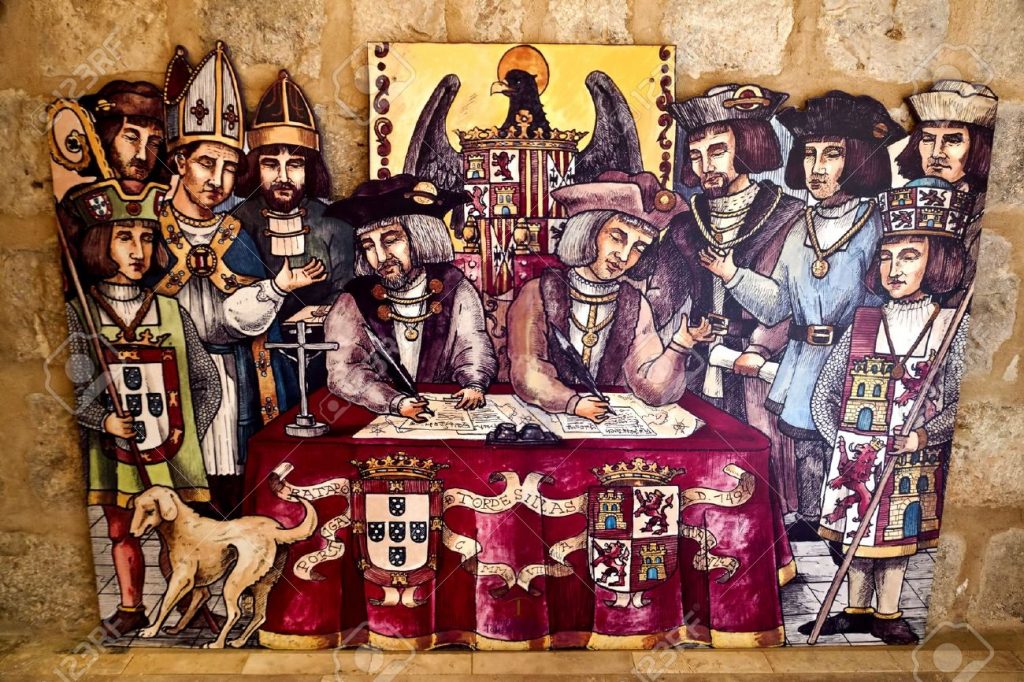The fifteenth century saw many changes for the nations of the “Old World.” It was the beginning of the age of exploration, and with that exploration came the exportation of their cultures, religion, and political power across vast, unexplored territories. What followed would be centuries of wars, treaties, and technological improvements that accelerated European dominance over Africa, the Americas, and parts of Asia. Two specific powers emerged during this early period as rivals: Portugal and Spain, with the latter eventually eclipsing the former through economic and political means. One event that helped propel Spain ahead of its competitor and gain numerous advantages was the treaty of Tordesillas.
The story, however, begins with Portugal taking the initial lead. In the early-fifteenth century, Portugal had begun to colonize several small islands in the Atlantic Ocean and some islands along the West African coast. It was not until 1488 that Bartolomeu Dias, appointed by King John II of Portugal, rounded the Cape of Good Hope and opened the way for Portuguese merchants to trade directly with India, and eventually with the East Indies.1 Spain also sought to establish trade with the East Indies, but only after a different route became possible subsequent to the voyages of Christopher Columbus.
Upon his arrival to the Americas, Columbus claimed all of the lands he visited for Spain. On his return, the Italian explorer stopped in Portugal and met with John II. After having learned of Columbus’ discoveries and the claims he had made for Spain, the Portuguese monarch grew upset and made his own claims to these lands. The king cited two pieces of writing as justification: the Treaty of Alcáçovas (1479) and the papal bull, Aeterni Regis (1481). These documents declared that Spain would control the surrounding area of the Canary Islands (near the coast of present-day Morocco) and Portugal would possess all of the lands to the west and south of this location.2 King John II believed that the lands discovered by Columbus were in the areas under Portuguese control as set forth by the 1479 treaty and the 1481 papal document. However, the Spanish monarchs, worried about their neighboring country’s claims, petitioned the leader of the Roman Catholic Church, Pope Alexander VI, to acknowledge their own claims to these lands.

The Supreme Pontiff Alexander VI (Roderic Borgia), a native of Aragon and personal friend of Ferdinand II, agreed with the Spanish monarchs and recognized their claims to these “new” territories.3 On May 4, 1493, in an effort to forestall future territorial disputes between Spain and Portugal, he issued a new papal bull, Inter Caetera Divinae, which formed an imaginary line running straight from the North and South poles. This line was located 100 leagues (345 miles) west of the Cape Verde Islands, which gave Spain control over all the territories west of this line, and Portugal gained control over those east of the line. The pope, however, specified that those lands already claimed by Christian sovereign powers would remain under their control.4
Spanish interests in the spice trade heavily influenced the position of the line since the monarchs believed the islands rich in spices were west of where Columbus had landed.5 If this had been the case, then Portugal would have effectively been excluded from trade with East Asia, giving all access to Spain. But Pope Alexander VI went even further with another papal bull, Dudum Siquidem, issued September 26, 1493, which gave Spain the right to claim lands discovered while traveling westward even if they fell in the Portuguese areas but had not yet been possessed by Portugal.6 John II was made furious by these bulls and threatened to send a fleet to Hispaniola to prevent the Spanish from colonizing those new areas. Thus, began new negotiations overseen by the same pope in 1494.

After much discussion and debate, the two Catholic powers agreed to place the imaginary line 370 leagues (1,277 miles) west of the Cape Verde Islands. Just like in Inter Caetera Divinae, Spain would possess all areas west of the line and Portugal all those east of the line. The treaty was ratified June 7, 1494 by both parties in the Castilian town of Tordesillas, and it was later recognized by Pope Julius II (successor of Alexander VI) in a papal bull in 1506.7 The treaty did have some flaws though, since it never clarified a standard for a league, (units of measure varied among the two countries), and it failed to mention which side of the Cape Verde Islands the measuring distance would start from.8 This led to a difficulty when establishing borders between the two colonial powers, because no one knew where the exact location of the line lay. The Treaty of Tordesillas was also rejected by England, France, and the Netherlands since the treaty excluded them from exploring the New World.9 As history later revealed, the treaty greatly benefited the Spanish monarchs and their economy. King Ferdinand II and Queen Isabella I gained vast amounts of colonial territory, which included colossal deposits of silver and gold. All of this eventually raised the prestige of Spain and made it the dominant power in Central and South America for centuries.
- Global Events: Milestone Events Throughout History, 2014, s.v. “Spain and Portugal Sign the Treaty of Tordesillas.” ↵
- Gale Encyclopedia of U.S. Economic History, 2000, s.v. “Tordesillas, Treaty of.” ↵
- Iberia and the Americas: Culture, Politics, and History, 2005, s.v. “Tordesillas, Treaty of (1494).” ↵
- Global Events: Milestone Events Throughout History, 2014, s.v. “Spain and Portugal Sign the Treaty of Tordesillas.” ↵
- Encyclopedia of Western Colonialism since 1450, 2007, s.v. “Treaty of Tordesillas,” by Alexander M. Zukas. ↵
- Iberia and the Americas: Culture, Politics, and History, 2005, s.v. “Tordesillas, Treaty of (1494).” ↵
- American Eras: Primary Sources, 2015, s.v. “Treaty of Tordesillas (Excerpt).” ↵
- Iberia and the Americas: Culture, Politics, and History, 2005, s.v. “Tordesillas, Treaty of (1494).” ↵
- American Eras: Primary Sources, 2015, s.v. “Treaty of Tordesillas (Excerpt).” ↵



56 comments
Stephen Talik
It’s funny to note that the idea of major loopholes in landmark agreements existed all the way back then. We tend to think of this as a more modern development (often along the lines of “a good lawyer can find a loophole in anything”) but the lack of specification seemed to be more by accident in this specific example than by design.
Aaron Sandoval
I found it very interesting how even in the late 15th century, it helped to know someone in power. In this case, as you mentioned, Pope Alexander VI was a close friend with Ferdinand II. It was this friendship that allowed Spain to not only get an upper hand in this conflict over territory but to essentially knock Portugual and John II out of what would later be known as the “New World” entirely. It was not until the issue was brought directly to the Pope that a sense of a fair treaty could be brought up and accepted by all parties, and as you mentioned the lack of specificity was a major drawback in the treaty that had the potential of being exploited.
Lulu Avitua-Uviedo
To learn from someone else’s research will always be beneficial to the one who wants to learn. Here you have taught me something I didn’t know much about. This article has peaked my interest to research this further myself. The imaginary boundary line, really isn’t so imaginary is it? We find in History there are still so many boundary lines as vestiges from the past.
Aracely Beltran
My great grandmother is French and my great grandfather is a Spaniard. It is so interesting to learn a little bit of history of other places. I was not aware of the Treaty of Tordesillas. Very well written essay. However, it really upsets me that Columbus would just show up to a piece of land and was like “okay, I found it” when there were already people there.
Antonio Holverstott
The treaty’s dividing line is the reason why Brazil is the only major Portuguese speaking country in Latin America, while the other countries’ major language is Spanish. Also, this would affect how Latin American countries broke away from their old parent countries. Countries that became independent through a violent revolution to become a republic, were under Spanish control. Brazil, however, became independent peacefully and was a constitutional monarchy for many years, unlike its Latin American counterparts.
Madelynn Vasquez
I had only briefly heard of the Treaty of Tordesillas of 1494, you were good at being informative! It’s always interesting to read on the dynamics of how countries will do the things they do in order to obtain more territory. More importantly, it is also good to recognize that the Catholic Church played a bigger role in colonialism during this time period than we might think.
Thiffany Yeupell
With all the efforts of Spain and Portugal attempting to colonize and find ways to not actively cross each other’s paths, the Treaty of Tordesillas seems more like a troubleshooting mechanism than a solution. The flaws remain blatant and the intentions are up in the air during its ratification, but it did provide a starting point. But even then, it excluded other powerful nations in Europe and opposition only increased. And given Cervantes’ rendition of the whole debacle between the two nations and the pope, a form of favoritism seems to be a factor, as Portugal had reaped the lowly leftovers in sense, compared to Spain’s occupation of prime land.
Shriji Lalji
I was not very familiar with this treaty. However it is good to see that both powers resolved their issue through diplomacy rather than war. I was appalled at how much power the pope had. It further goes to show the significance of religion during that time. I am a little curious as to the ways the age of exploration contributed to globalization.
Jose Chaman
This is the first time I have read the history of the Treaty of Tordesillas more deeply. First of all, I was completely unaware of the existence of the Treaty of Alcáçovas (1479) and the papal bull, Aeterni Regis (1481), which gave Portugal the right to own the lands found by Colon. In the same way I have been able to understand the great role that the Catholic Church had during the Conquest and the colonial era.
Ariana Melendez
I was not that familiar with the Treaty of Tordesillas before reading this article. You do a great job at explaining what led up to this treaty as well as its flaws. It made me more curious to learn about the struggles the countries had with each and how this treaty impacted each of them. It also explains why Spain is a superior power in Europe.